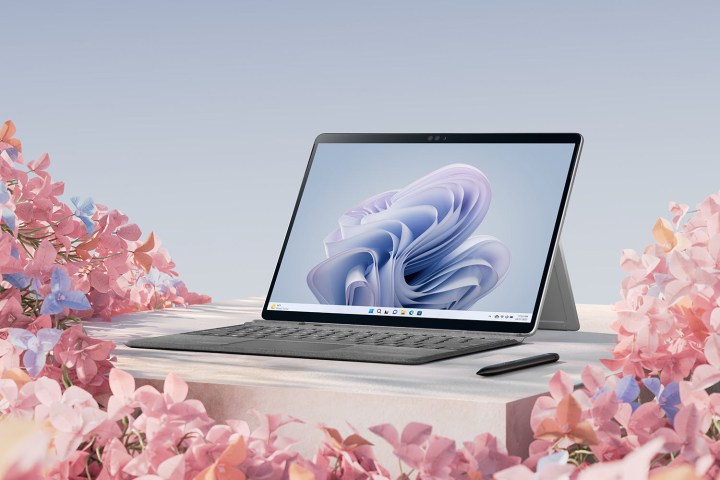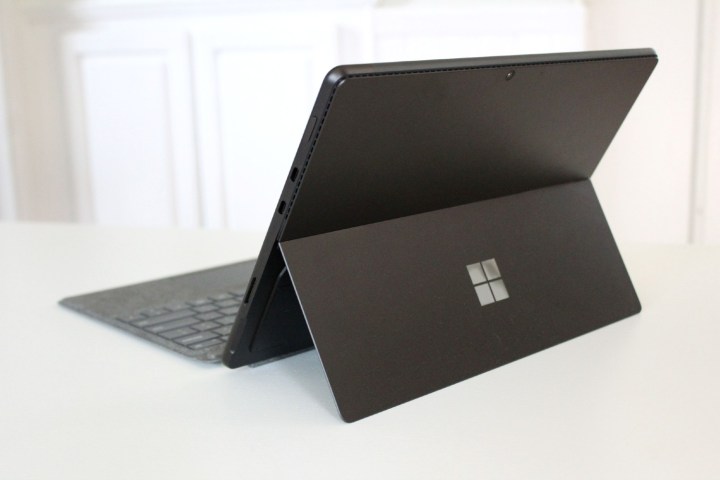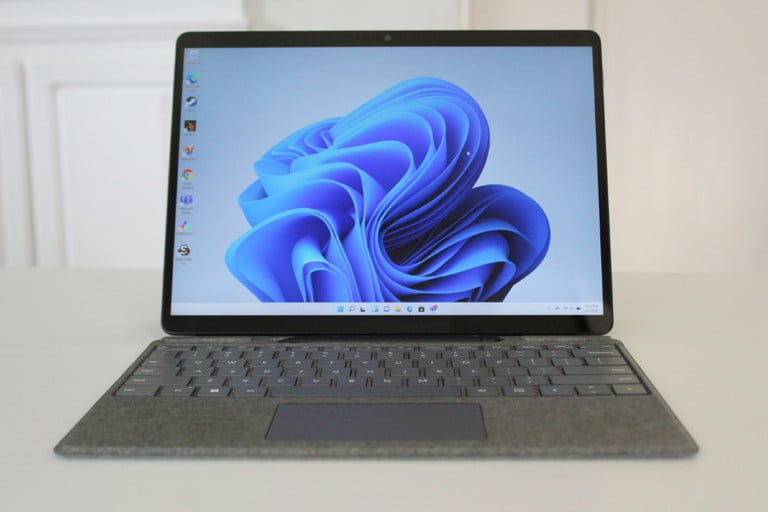The Microsoft Surface Pro has spent years on our best laptops and best 2-in-1s lists. The Surface Pro 8, which represented the most significant revision to the tablet in years, maintained that spot.
Microsoft has introduced the Surface Pro 9, which retains the same basic design while updating the internals. Read on to find out if the newest Surface Pro is worth an upgrade.
Specs
| Microsoft Surface Pro 8 | Microsoft Surface Pro 9 | |
| Dimensions | 11.3 inches by 8.2 inches by 0.37 inches | 11.3 inches by 8.2 inches by 0.37 inches |
| Weight | 1.96 pounds (tablet only) | 1.94 pounds |
| Processor | Core i5-1135G7 Core i7-1185G7 |
Intel Core i5-1235U Intel Core i7-1255U Microsoft SQ 3 (5G models) |
| Graphics | Intel Iris Xe | Intel Iris Xe Microsoft SQ 3 Adreno (5G models) |
| RAM | 8GB 16GB 32GB |
8GB to 32GB LPDDR5 8GB or 16GB LPDDR4x (5G model) |
| Display | 13-inch 3:2 IPS 3K (2880 x 1920) | 13-inch PixelSense 2880 x 1920 IPS display up to 120Hz |
| Storage | 128GB PCIe solid-state drive (SSD) 256GB PCIe SSD 512GB PCIe SSD 1TB PCIe SSD |
128GB to 1TB removable SSD 128GB to 512GB removable SSD (5G models) |
| Touch | Yes | Yes |
| Ports | 2 x USB-C with Thunderbolt 4 1 x Surface Connect 1 x Surface Keyboard port 1 x 3.5mm audio jack MicroSD Card reader |
2 x USB-C with Thunderbolt 4 1 x Surface Connect port 1 x Surface Keyboard port 1 x 3.5mm audio jack 1 x nano SIM (5G models) 2 x USB-C 3.2 (5G models) |
| Wireless | Wi-Fi 6 and Bluetooth 5.1 | Wi-Fi 6E and Bluetooth 5.1 Optional 5GB WWAN |
| Webcam | 1080p with infrared camera for Windows 11 Hello 10MP rear-facing |
1080p with infrared camera for Windows 11 Hello 10MP rear-facing |
| Operating system | Windows 11 | Windows 11 |
| Battery | 51.5 watt-hour | 60 watt-hour |
| Price | $800+ | $1,000 |
| Rating | 4 out of 5 stars | Not yet reviewed |
Price and configurations
The Surface Pro 9 will start at $1,000 for the Intel Core i5 configuration, which comes with 8GB of RAM, and 128GB of SSD. The cheapest SQ3 configuration will start $1,100, while you’ll need to pay $1,400 to get the entry-level 5G model. The Surface Pro 8 had a starting price of $1,100 for a Core i5, 8GB of RAM, and a 128GB SSD. At the high end, the Surface Pro 8 was originally priced at $2,600 for a Core i7, 32GB of RAM, and a 1TB SSD. Currently, the Surface Pro 8 is on sale from $800 to $2,200.
As usual, the $130 Signature Type Covers and the $130 Surface Pen 2 are optional add-ons that increase the cost of a fully configured tablet.
Design

The Surface Pro 8 was a significant revision from earlier Surface Pro models. It incorporated a larger 13.0-inch display, up from 12.3 inches, with smaller side bezels and a more rounded chassis. It maintained the full-friction kickstand built into the back cover, which flips out from the center to provide a wide range of motion. It’s one of the better kickstands available on detachable tablet 2-in-1s. The Surface Pro 8 also switched to an all-aluminum chassis from the magnesium alloy used on previous models, which gave it an even more solid feel and added a small amount of weight. As is the case with every Surface machine, the Surface Pro 8 has an incredibly solid and quality build that rivals the best laptops available.
The Surface Pro 9 maintains the same design and thus benefits from the same qualities. The only change is the addition of two new colors, with Sapphire and Forest joining Platinum and Graphite (the 5G model, discussed below, is limited to Platinum). There’s also a Liberty Special Addition with its own engraved design. All the chassis colors are matched with Signature Type Covers to maintain a cohesive color scheme.
Speaking of the Type Covers, they enjoy the same design as before. That means they have light, snappy switches with plenty of travel and a comforting bottoming action. They’re as good a typing experience as you’ll find on the best clamshell laptops, except for some bounce when the keyboards are magnetically propped up at an angle. The touchpads are small but functional, with comfortable swiping surfaces, reasonably quiet clicks, and support for Windows 11’s multitouch gestures. Both displays support touch, of course, along with the Microsoft Surface Pen 2 with its haptic feedback that more closely mimics pen on paper.
The Surface Pro 9 Intel version’s connectivity mimics the Surface Pro 8, with two USB-C ports with Thunderbolt 4 support, a Surface Connect port, and a 3.5mm audio jack. Microsoft doesn’t list a microSD card reader in the Surface Pro 9 specs, so that might be a loss over the Surface Pro 8. The 5G version of the new machine is limited to USB-C 3.2 without Thunderbolt 4 and adds in a nano SIM slot for the 5G WWAN connectivity. Both tablets offer Wi-Fi 6E and Bluetooth 5.1.
Performance

The Intel version of the Surface Pro 9 uses Intel 12th-generation CPUs running at 15 watts and sporting 10 cores (two Performance and one Efficient) and 12 threads. That compares to the Surface Pro 8 that used 28-watt Intel 11th-gen CPUs with four cores and eight threads. There are significant platform differences between the CPUs, but in our testing, the Core i5-1235U and Core i7-1255U have been faster than the equivalent 11th-gen Intel part in our suite of benchmarks. The Surface Pro 9 also benefits from an upgrade to faster LPDDR5 RAM, up from the LPDDR4 memory in the Surface Pro 8.
We’ll have to wait for our review to be certain, but the Intel Surface Pro 9 is likely to provide a significant boost in productivity performance. The integrated Intel Iris Xe graphics haven’t changed much, though, so creativity and gaming performance isn’t likely to have improved much.
The 5G Surface Pro 9 is a different story entirely. It uses Microsoft’s SQ 3 CPU, which is a custom version of Qualcomm’s Snapdragon 8cx Gen 3 ARM processor. In our experience, that’s a CPU that’s competent at typical Windows productivity workflows but won’t keep up with the Intel options. The Qualcomm Adreno graphics also won’t be as fast as the Intel version. One advantage of the 5G version is that it will run cooler and therefore doesn’t need the Intel version’s active cooling.
Display

Surface devices almost universally enjoy reasonably bright IPS displays with excellent contrast and high resolutions. They don’t usually have better-than-average color saturation. That describes the display on the Surface Pro 8 perfectly, and it’s likely that the Surface Pro 9 display will perform the same way. According to its specifications, the new model enjoys the same 120Hz refresh rate for an ultra-smooth Windows 11 experience and superior inking, which combines with the haptic feedback in the Surface Pen 2 for more realistic inking.
That’s not to say that the Surface Pro 9 brings no display improvements. Microsoft has adapted a few technologies, such as Auto Color Management and Adaptive Color, along with Dolby Vision IQ for enhanced high dynamic range (HDR) images. We’ll have to confirm the benefit of these new features in our review, but on paper, the Surface Pro 9 is an improvement.
Portability

Also unchanged is the Surface Pro 9’s size, which is identical to the Surface Pro 8. It’s not the lightest nor thinnest tablet you can buy, but both are still highly portable and easy to toss into a backpack. Adding a Type Cover increases thickness and weight, but even then, the combination is similar to other 13-inch laptops.
We haven’t tested battery life yet, but the Intel version is likely to get higher battery life thanks to 12th-gen efficiencies and the Surface Pro 9’s larger battery. That would result in excellent battery life for a detachable tablet, at around nine hours of web browsing and 11 hours of local video. The 5G version should have considerably longer battery life than the Intel Surface Pro 9 and the Surface Pro 8. ARM processors are significantly more efficient and made for all-day use, and we expect that to be the case with the 5G Surface Pro 9.
Intel or ARM, the Surface Pro 9 is a meaningful update
The Surface Pro 9 adds some color and a choice of fast and more efficient Intel 12th-gen CPUs or a longer-lasting ARM processor with always-connected 5G internet. If prices remain the same, the Surface Pro 9 will have taken what’s great about the Surface Pro 8 and made it better.
We’ll have to conduct our review to be sure, but if you’re looking for your first detachable tablet, then it’s worth the wait until the Surface Pro 9 officially ships. If you already have a Surface Pro 8, then you’ll have to decide if the extra performance or always-connected internet and long battery life are worth the investment.
Editors’ Recommendations




